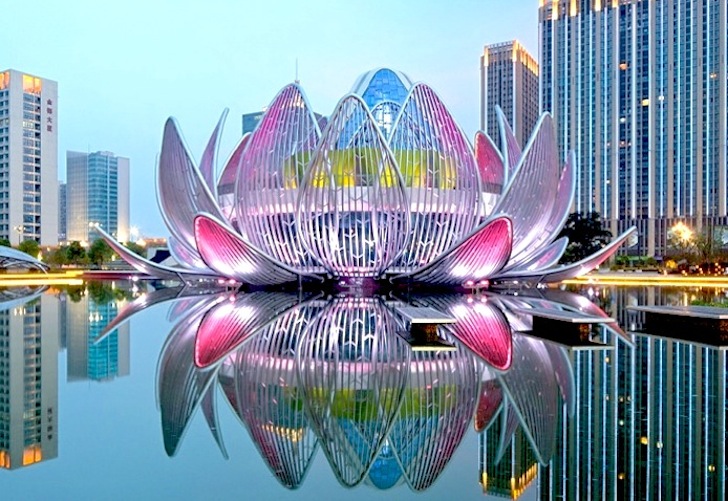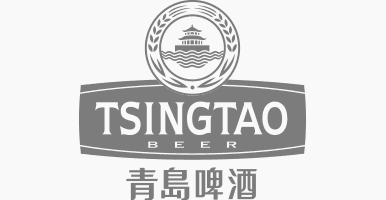Always looking for ways to triumph within business and air its affluence, China has more than cemented itself as home to some of the world’s most unique and, at times, truly bizarre architecture.
Not satisfied with just the title of creating the tallest skyscraper on the globe, China knows no half measures, instead challenging architectural possibilities to create everything from a giant lotus to a free-standing hula hoop structure.
The country’s futuristic and fantastical creations have just this year been described as ‘devoid of cultural tradition’, with China’s central government calling upon an end to the ‘oversized, xenocentric, weird’ architecture that has been popping up one brick (or glass sheet or steel slate) at a time.
But for now, you can marvel at these seven weird and wonderful architectural creations that fill China’s landscapes.
China Central Television (CCTV) Headquarters (Beijing)
 The China Central Television (CCTV) Headquarters in the Beijing district of Dongcheng caused quite a stir when the building was unveiled back in 2012. Being coined the ‘Giant Underpants’ by the media, the structure’s pronged shape bares an uncanny resemblance to a pair of trousers.
The China Central Television (CCTV) Headquarters in the Beijing district of Dongcheng caused quite a stir when the building was unveiled back in 2012. Being coined the ‘Giant Underpants’ by the media, the structure’s pronged shape bares an uncanny resemblance to a pair of trousers.
Rem Koolhaus and Ole Sheeran are behind this architectural ‘genius’ for one of China’s major public divisions. Accommodating TV studios, media offices, and broadcasting and production facilities, the building reinvents the traditional model of a skyscraper, acting as a domineering double tower on the Beijing skyline.
The Guangzhou Circle (Guangzhou)

Resembling a giant coin, the Guangzhou Circle not only exudes wealth from its exterior façade, it is also the home to some of China’s most profitable businesses. Acting as the headquarters of the Hongda Zingye Group and the venue of the Guangdong Plastic Exchange (GDPE) – the world’s largest stock exchange for raw plastic – the building rises up from the banks of the Pearl River in terrific grandeur.
Totalling 138 metres in height and covering 33 stories, Italian architect Joseph di Pasquale’s design is a real proclamation of wealth within the city of Guangzhou.
Ring of Life (Fushun)
Another circular frame sitting on the water banks, the Ring of Life (or Circle of Life) in the city of Fushun is a landmark from miles around and attracts a buzzing crowd of tourists to the region.
Made from approximately 3,000 tons of steel and costing a lavish $16 million US dollars to build, the 157-metre, 50-storey structure is really a sight to behold. Although it received mixed critical responses when it was finalised by architectural firm Shanghai Modern Architectural Design Co. in 2012, the emblematic structure remains undeniably a pinnacle on the district’s shoreline at night, when 12,000 LED lights bring it to life, illuminating the whole area.

Lucky visitors can head to the upper decks for stunning views over the city from the building’s observation tower.
The Lotus Building (Wujin)

Blossoming all year round, The Lotus Building brings a stunning touch of manmade nature to Wujin’s cityscape. Sitting atop an artificial lake, the building symbolises the ambition and future aspirations of the district’s government it houses in its offices.
Designed by Australian architecture and design studio, studio505, the beautiful building is energy efficient, providing a sustainable geothermal system driven through the lake.

Entering the building is just one of its many marvels – visitors get into the futuristic floral structure through an underground location beneath the lake, appearing in a cathedral-inspired space of kaleidoscopic light and colour.
Tianzi Garden Hotel (Beijing)

You may be taken by surprise if you stroll the outer streets of Beijing. Looming up on one side of the road in the little town of Langfang in the Hebei Province are three god-like figures that form the Tianzi Garden Hotel, otherwise known as the Son of Heaven Hotel.
The ten-storey hotel broke the Guinness World Record in 2001 for being the ‘world’s biggest image hotel’ – the god’s embody Chinese tradition, with Shou, the god of longevity; Fu, the god of fortune; and Lu, the god of prosperity. Word has it that there is a special guest suite in the peach held in Shou’s hand.
Sheraton Huzhou (Huzhou)
The curved, horseshoe-like structure of the Sheraton Huzhou stands out like a beacon on the Huzhou skyline. At night the hotel casts a mesmerising neon glow across the city, with its lights sparkling in the surrounding Taihi Lake.

If the structure wasn’t impressive enough, it continues underwater to complete a full oval, with rooms situated beneath the depths. Futuristic and ethereally placed just on the edge of the city, the hot springs resort is the perfect destination to relax without having to stray too far from the bustling Huzhou.
The Piano House (Huainan)

Looking like something conjured from a giant dollshouse, The Piano House building is a fascinating creation made entirely from glass. Featuring a stately black grand piano-shaped building and an elegant violin-shaped high-rise, complete with a glass staircase within the violin leading into the piano, the exquisite structure is the classical jewel of Huainan’s crown. It’s even been dubbed as ‘the most romantic building in China’ by the locals.

Designed by architectural students of Hefei University of Technology in 2007, as a way to throw the area into the public eye and invite interest from further afield, the space remains deeply rooted in the creative industries, serving as a showroom for exhibiting plans for Huainan’s newly created district of Shannan.
With the death of China’s unique architecture looming on the horizon, it has never been a better time to stand back and admire the unusual structures the country has given to the world.


